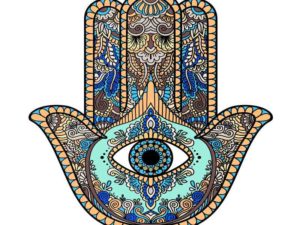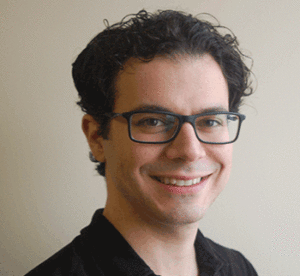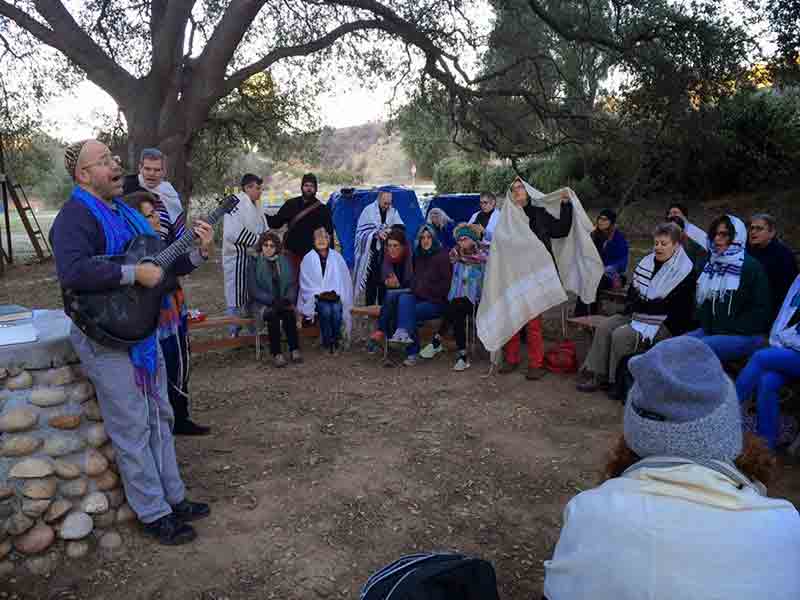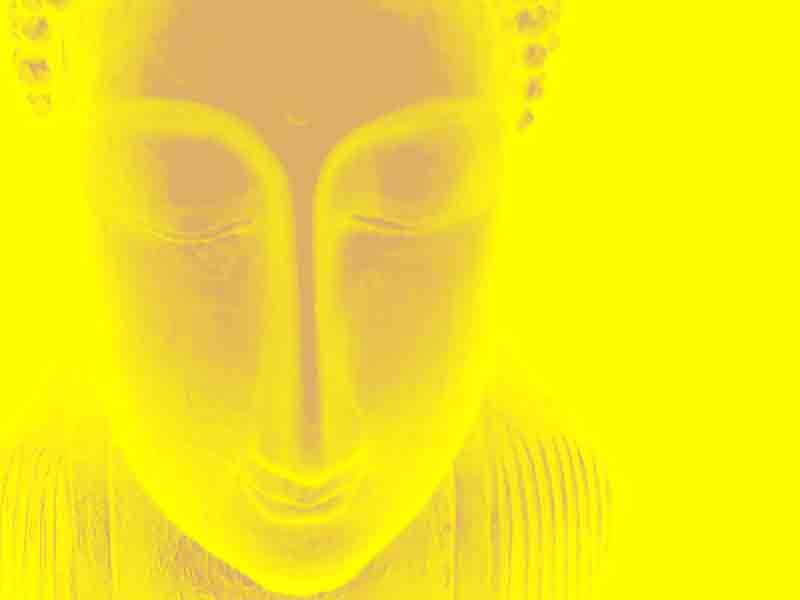About 15 years ago, Matthew Gindin was sitting in a Quebec ashram, experiencing a sort of crisis of faith.
Then 24, Gindin was both a lapsed Jew and, more recently, a lapsed Buddhist monk.
He had left the California monastery where he’d been ordained, and where he followed a branch of Theravada Buddhism.
Gindin, a freelance writer for The CJN, had been deeply happy in the monastery, relishing the solitude and simplicity, as well as the long hours of silent meditation.
The problem was that the better he felt, the less motivated he was to meditate. And the newly joyful part of him had begun to chafe against the Theravada Buddhist view of the world as fundamentally impersonal and running on karma with, as he put it, “no one running the show.”
The idea, he explained, is that “by freeing the heart from delusion and desire, you experience peace in this lifetime, but you also get released from the cycle of reincarnation.… Sometimes, it can feel like the universe (is) a futile, even negative place, which you want to escape.”
In retrospect, Gindin, wondered if his reaction was evidence of some dormant “Jewish feelings.” He noted that Judaism believes “creation has a purpose.” And he felt that “despite all the suffering in the world, there’s a beautiful, mysterious aspect to being and life.”
Rather than diving back into Judaism, he first gravitated to Hinduism, because he liked its view that “there’s a positive spiritual reality at the heart of the universe.”
So he moved back to his hometown of Winnipeg and got certified as a yoga teacher and an Ayurvedic counsellor.

But as he delved deeper into Hinduism, he felt less inclined to it, realizing that the religion’s ultimate path is a monastic one that advocates retreating from worldly attachments. Instead, he craved a way of being that embraced both “normal and spiritual life.”
The cultural Judaism of his childhood had left him wholly unsatisfied. But that started to change when he stumbled upon a book by the Lubavitcher Rebbe and was struck by a passage emphasizing the importance of recognizing the sacred in daily life.
All of this was on his mind that crucial day in the Quebec ashram, as he wrestled with the idea of returning to Judaism, in order to examine its spiritual aspects.
Though he’d never prayed, Gindin decided to “open (himself) to a higher power and ask for a sign.” Minutes later, his “sign” arrived: the group assembled in the ashram stopped chanting and the swami began to read aloud from a book. The paragraph he chose that day was from a chapter summarizing the teachings of different world religions. It was about Judaism.
Recalling the incident, Gindin laughed, noting, “I thought I’d have to be an idiot not to explore (Judaism) further.”
In the decade since, Gindin has studied and taught Jewish spiritual texts and found that Jewish meditation, while perhaps not well known by contemporary, non-chassidic Jews, very much exists.
Rebbe Nachman of Breslov, for example, who lived in the 18th and early 19th centuries and was known for fusing kabbalistic elements with in-depth Torah scholarship, promoted the practice of hitbodedut, an unstructured, individualized form of direct communion with God that lends itself to various silent meditation techniques.
There are also the pre-Second World War chassidic writings on kabbalistic teachings (many of these, and their authors, were wiped out in the Holocaust). For example, Reb Kalonymos Kalman wrote about enhancing one’s awareness of reality and taught a method called hashkata – a quieting of the mind, in order to facilitate focus and meditation.
Gindin eventually re-embraced some elements of Buddhism. He now runs a Jewish meditation group in Vancouver that primarily uses Jewish meditation methods, but also incorporates wisdom and tools from Buddhist and Vedantic meditation.
Gindin’s trajectory may be eclectic, but the story of a Jew drawn to Buddhism is hardly novel.
‘a striking number of the teachers who popularized variants of Buddhism in the U.S. came from Jewish families’
In fact, the phenomenon is so prevalent that there’s a household name associated with it.
The neologism “Jubu” (alternately spelled “Jewbu”) entered common parlance as a result of Rodger Kamenetz’s 1994 book, The Jew in the Lotus. Centred on a historic dialogue between a group of rabbis and the Dalai Lama, it drew widespread attention to the interest many American Jews were showing in the eastern religion.
Though flourishing in the 1950s and ’60s, the Jewish affinity for Buddhism goes back quite far. In her dissertation turned book, American JUBU: Jews, Buddhists, and Religious Change in the United States, sociologist and Duke University postdoctoral fellow Emily Sigalow writes that the first non-Asian person in the U.S. to convert to Buddhism was Charles T. Straus – a Jewish hat maker – in 1893.
Indeed, a striking number of the teachers who popularized variants of Buddhism in the U.S. came from Jewish families. They were among the swarm of young Westerners travelling to Asia after the Second World War, looking for immersive spiritual training.
In 1976, three of them – Sharon Salzberg, Jack Kornfield and Joseph Goldstein – founded the Insight Meditation Society (IMS) in Barre, Mass. Rooted in the Theravada Buddhist tradition, the IMS has been extremely influential in disseminating insight meditation (also known as Vipassana), a kind of universalized – and arguably secularized – Buddhism developed in North America.
A Canadian outgrowth of IMS, True North Insight (TNI), was later established. The organization has no physical location, but rents spaces for retreats held mostly in Montreal, Ottawa and Guelph, Ont.
‘A lot of the Jewish community is focused on survival for the sake of survival. For many it can feel…grim
Norman Feldman, one of TNI’s founders, has taught insight meditation around the world for decades.
“Certainly it’s true that a lot of leaders in the insight meditation Western tradition began as, or are, Jewish,” he told The CJN.
Feldman attended Hebrew school as a child, but lost interest in Judaism around the time of his bar mitzvah.
“What I was taught seemed very academic and not relevant to my life,” he said. “I had the sense that what I heard in synagogue wasn’t applied in people’s lives and that a lot of attention was given to materialism and wealth. That didn’t appeal to me.”
At 23, he went to India and discovered Buddhism. In 1971, he attended his first Vipassana retreat and from then on, he said that he was “hooked.”
Vipassana provided practical tools that allowed him to “examine the self and its relationship with others, and the world.”
Avi Craimer, 35, is a meditation teacher and spiritual guide from Calgary, who’s now living in Toronto.
Craimer grew up in what he called a “liberal, traditional” Jewish home, though his family attended an Orthodox synagogue. As a teenager, he was drawn to a more rigorous Jewish practice, but he soon drifted from the Orthodox world, finding it difficult to accept some of the community’s views on the inclusion of women and LGBTQ Jews.
As his connection to spiritual Judaism waned, he began reading about, and practicing, Buddhist meditation.
At first, he said, “I wasn’t looking for a spiritual alternative (to Judaism), just for a practice to help me feel better in my life, to relax.”
That changed after the meditation practice “triggered a sort of spiritual opening, where, for the first time, (he) had a direct experience of God’s presence.”
READ: WILL THE JEWISH COMMUNITY INCREASINGLY REFLECT AN ORTHODOX AGENDA?
Nowadays, Craimer teaches mediation courses and does one-on-one spiritual counselling with individuals from a range of backgrounds, helping some integrate mediation techniques with their Jewish beliefs and values.
Craimer has led meditation at a synagogue’s Yom Kippur services and sits on the board of directors at a non-denominational, Toronto-based meditation organization called the Consciousness Explorers Club.
He posited several theories as to why so many Jews are attracted to Buddhism.

For one, Judaism puts a strong emphasis on external action. “In shul, you can feel like you’re rushing through the texts,” he explained. “In Buddhism, you’re sitting in silence … paying attention to your breath and body. This can feel like a huge relief for someone who feels like religion has been this harried thing.”
His second theory pertains to suffering. “Judaism’s response to suffering is to put faith in God’s ultimate goodness, in (a) Divine plan, or messianic age,” Craimer said. “But as many scholars have noted, this ‘answer’ of messianism was undermined for many Jews by the horrors of Holocaust.”
In Buddhism, one escapes suffering not through a reliance on an external god, but “through the skillful effort of your own mind,” he said. Meditation doesn’t promise to remove worldly pain, he explains, it allows the individual to detach from its impact.
Thirdly, modern Jewish practice, especially of the non-Orthodox varieties, tends not to offer much in the way of access to mystical realms.
“I think I was originally drawn to the Orthodox world because I felt like there, people at least believed in God and prayed,” Craimer said. He couldn’t sustain his interest though, finding the Orthodox movement’s emphasis on Halachah to be too abstract.
Buddhism filled that gap, he said. “I think it connects the dots for a lot of Jews, in terms of how to get from desiring transformation of consciousness to an actual experience of transformation.”
Miriam Margles is a Reconstructionist rabbi and leader of Toronto’s Danforth Jewish Circle.
Raised in the Conservative movement, from a young age she experienced “a palpable sense of divine presence.” But as she got older, Rabbi Margles found those experiences harder to come by in a traditional, institutional Jewish context.
In university, Rabbi Margles discovered kabbalistic teachings that viewed the Torah, mitzvot and prayer as “pathways to accessible, immediate encounters with the sacred … to growth and self-awareness,” she said.
She later read contemporary works by people such as Rabbi Alan Lew, Rabbi Jonathan P. Slater and Rabbi James Jacobson-Maisels, who were “involved in bringing Jewish texts on meditation to life and feeding in experiences of Vipassana and Zen.”
“I was excited to find that so much of what my soul was bursting for could be found in Jewish sources – sources that talked about mysticism and meditation practices,” Rabbi Margles said.
For years, she has both taught at, and studied with, the New York-based Institute for Jewish Spirituality. And at her own synagogue, she leads a weekly Shabbat morning meditation circle.

While Rabbi Margles sees the mystical aspects of Judaism as offering portals to spirituality, she acknowledges that, for many Jews who feel alienated from Judaism, Buddhism can feel like an antidote to a religion that may feel restrictive.
“It can feel like one must study the entire library of Jewish sources and commentary to maybe have a resonant experience … like there are so many hurdles before you get to the depths of spiritual encounter,” she said.
She also believes that the impact of generations of anti-Semitism on the collective Jewish psyche has created a sense of heaviness.
“A lot of the Jewish community is focused on survival for the sake of survival,” Rabbi Margles said. “For many encountering this, it can feel … grim. And then you walk into a Buddhist sangha and it’s unencumbered by all that historical weight.”
Rabbi Margles is hopeful, however, about the prospect of Jewish healing.
“I think there’s beautiful opportunities in how these practices (of Buddhism and Judaism) can converge and speak to each other,” she said.
For some Jubus, the allure of Buddhism has led to them leaving Judaism altogether. Others have found ways to meld the two – to find, often Buddhist-informed, Jewish practices and a way of life that gives them the direct spiritual access they so crave.



